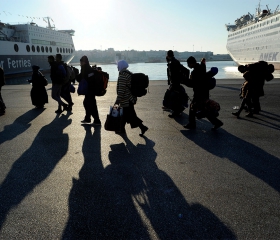Contrary to the expectations of Euro-optimists, the 30-year anniversary of the Schengen Agreement (signed on June 14, 1985) was not marked by a celebration of the creation of a unique free movement zone. The celebratory mood was overshadowed by the largest refugee crisis of the 21st century in the European Union. Until recently, disputes arising between states within the European Union boiled down to how to build a pan-European policy, with refugees entering Germany, France and other western countries. Now the crisis is threatening the Schengen Area as a whole.
Contrary to the expectations of Euro-optimists, the 30-year anniversary of the Schengen Agreement (signed on June 14, 1985) was not marked by a celebration of the creation of a unique free movement zone. The celebratory mood was overshadowed by the largest refugee crisis of the 21st century in the European Union. Until recently, disputes arising between states within the European Union boiled down to how to build a pan-European policy, with refugees entering Germany, France and other western countries. Now the crisis is threatening the Schengen Area as a whole.
Despite the fact that that Schengen Agreement was signed in 1985, its provisions only started to come into force ten years later, when border controls were scrapped at the internal borders of seven states. Once the remaining EU members (with the exception of the United Kingdom and the Republic of Ireland) joined the agreement and a unified policy with respect to persons entering from third countries had given the area its final shape, Schengen became a symbol of European integration. The Schengen Agreement has also contributed to the development of pan-European cooperation in the judicial, police and intelligence spheres. Since controlling the internal borders of EU states is impossible, the European Agency for the Management of Operational Cooperation at the External Borders (Frontex) was set up in 2004, with its headquarters in Warsaw. Paradoxically, this mechanism designed to eliminate internal borders, which flourished for almost 20 years, became one of the main problems facing the European Union following the migrant crisis of 2015.
The history of the Roman Empire appears to be repeating itself like never before. Citizens of the Roman Empire could move freely within its borders. The only exception was Egypt, whose inhabitants were required to present a kind of passport upon leaving the country. People were drawn to Rome in the same way that people are drawn to Berlin and Paris today. The overwhelming majority of those immigrating to Rome were young, single men trying to build a new life for themselves in what was then the capital of the world. With Huns and other nomadic ethnic groups becoming integrated into the Roman Empire in the 4th century AD, Goths and other Germanic peoples were allowed into the republic. They subsequently ransacked Rome, thus contributing to the fall of the Western Roman Empire.
The purpose of this analogy is not to demonstrate the manner in which events will unfold in Europe, but rather to show how the migrant crisis is perceived by the majority of the European population. The movement of migrants towards Western Europe and the events associated with it – the terrorist attacks in Paris and other European cities that were carried out by people who had returned, unchecked, from Syria, and the assaults on women perpetrated on the streets of Cologne and Berlin – have caused people in the West to rethink the very existence of the Schengen Area.
The 26 states that make up the Schengen Area have come up against problems before. For example, Romania and Bulgaria are still waiting to be accepted into the zone after nine years of trying (Finland and the Netherlands expressed the greatest concerns about admitting the two countries). Romania and Bulgaria attempted to tie migrant quotas to their admission in the Schengen Area, although it is unlikely that Western European countries, which have thus far been unable to develop a common policy with regard to migrants from the Middle East, will welcome the prospect of an additional influx of people from Southeast Europe. Nevertheless, the main obstacle to improving the Schengen is not the fact that no decisions have been made, but rather that the European people have lost faith in the mechanisms of the free movement zone.
The November 13, 2015 terrorist attacks in France provided the most obvious reason to leave the Schengen Area. There is a strong possibility that the three-month state of emergency declared by the government will be extended indefinitely, until Islamic State has been defeated. Such a scenario could very well lead to the perpetuation of an “intermediate position” that is not specified in the framework of the Schengen Agreement. It is telling that 70 per cent of the French population is in favour of restoring borders within the European Union. The fact that almost 90 per cent of National Front voters support the idea should come as no surprise, and neither should the figures shown by the new-look Republican Party (formerly the Union for a Popular Movement, or UMP). However, the fact that the majority of the Socialist Party’s electorate are also calling for the borders to be restored suggests that the Schengen Area in its current form is unacceptable to the people of France. And it will be even less acceptable if more terrorist attacks or assaults are carried out by refugees.
Nevertheless, the interests of the population do not dovetail entirely with the political capabilities of French officials, and we should not expect France to officially leave the Schengen Area any time soon. Reforming or abolishing the Schengen Agreement requires the consent of all 26 member countries. The text of the agreement does not allow individual countries to withdraw from or make amendments to the agreement.
The European structures must in quick order offer a viable alternative to its states in order to overcome the refugee crisis. Perhaps the suggestion put forward by former President of France Nicolas Sarkozy in 2014 to create a Schengen 2 Agreement that would place stricter requirements on its member states will in some form or other enter the discussions of European officials. As things stand, President of the European Commission Jean-Claude Juncker admits that there is no practicable solution, yet he warns against reintroducing national borders within the European Union, as this would result in the “collapse of the entire Eurozone” .
The future of the Schengen Area may develop along two vectors: reforming the free movement area, or returning to a system of national border controls. The first option would not require significant expenditure, although it is extremely difficult to implement from the political point of view, as the interests of 26 very different states have to be taken into account. The second option is practicable from a political po int of view; however, it will result in economic losses – in addition to having to rebuild the border control system and the intelligence services, the increased time for cross-border trades to be completed will affect company revenues and price levels. Given these difficulties, the course proposed by Brussels will most likely be to reform the Schengen Area within politically acceptable limits.
EU representatives will need to demonstrate outstanding diplomatic skills in order to resolve the current crisis: first of all, they need to relocate 160,000 of the 1 million-plus migrants that entered the European Union in 2015; reform the Schengen Agreement in such a way that it does not allow for any country to exit the Schengen Area unilaterally; and decide the fate of 120,000 migrants from Kosovo and Albania fleeing neither war nor persecution, but rather the lack of economic prospects. And all this against the background of the possible exit of the United Kingdom from the European Union next year.
Представителям Европейского союза потребуются недюжинные дипломатические способности для урегулирования нынешнего кризиса – для начала им придется распределить по странам ЕС 160 000 людей из более миллиона прибывших в 2015 г. мигрантов; попытаться реформировать правила Шенгена, не допуская возможности выхода; решить судьбу 120 000 мигрантов из Косово и Албании, бежавших не от войны или преследования, а от отсутствия экономических перспектив – и все это на фоне возможного выхода Великобритании из структур ЕС в следующем году.
If any country is likely to leave the Schengen Area, then that is Switzerland or Norway. They are not EU member states, but they do belong to the Schengen Area and their exit from the free movement area would have almost no effect whatsoever on the political situation in the respective countries. Switzerland imposed immigration quotas following a referendum in 2014 which directly affect EU citizens as well. The growing popularity of the conservative Swiss People’s Party, with its Eurosceptic positions, could become a driving force behind an exit from the Schengen Area, while retaining economic ties with the European Union. Norway has already introduced border control and intends to deport migrants who have entered the country via the “northern route”, that is, through northern Russia. If migrant flows from Russia and Sweden continue to grow, then Oslo will most likely tighten border controls.
In recent months, six countries have reintroduced border controls: Austria, Germany, Denmark, Norway, Sweden and France. Hungary and Slovenia, representing the southern border of the Schengen Area, have tightened controls along the borders with Croatia, Serbia and Romania. When the three-month period of border control in Austria and Germany comes to an end in February, other countries may follow suit, creating a domino effect, if the European Union does not take the necessary measures. Calls were made at a meeting of EU foreign affairs ministers in late January 2016 to limit the scope of the Schengen Agreement within two years. If this initiative is put into action, then restoring the Schengen Agreement in its previous form will become an impossibility.
The Schengen Area has become a powerful driver for the development of cross-border socioeconomic ties in Europe: 1.25 billion border crossings are recorded every year; around 7 million EU citizens commute to work in a neighbouring country; and more than 11 million people have moved abroad thanks to the freedoms afforded by the Schengen Agreement. The Schengen Area can be saved by comprehensively sealing the external borders and extending the mandate of the European Union’s border authorities, subordinating them to the armed forces and giving them rights to combat the flow of migrants, although this would involve sacrificing the principle of protecting human rights. The wait-and-see position of the European authorities – at the time of writing, only 300 migrants have been relocated as part of the redistribution efforts, even though 500 times this amount is required – will not yield any positive results. Risky steps need to be taken.







